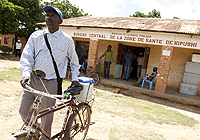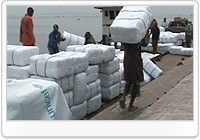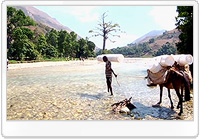About UNICEF
The road to equity: UNICEF uses every mode of transport to reach the most vulnerable
 |
| © UNICEF/NYHQ2011-0414/Asselin |
| Assistant Nurse Guy Bakatumaka pushes a bicycle carrying an icebox full of vaccines, which he has just collected from the UNICEF-assisted health centre in DR Congo. |
UNICEF’s equity-based approach to achieving the Millennium Development Goals aims to reach the poorest and most vulnerable children and families with cost-effective interventions for sustainable progress. Here is one in a series of stories that make the case for equity.
By Chris Niles
NEW YORK, 26 May 2011 – With programmes in more than 150 developing countries, how does UNICEF get resources and services to those who most desperately need them? By any means available.
UNICEF and its partners use everything from bicycles and mules to canoes, motorcycles and horse-drawn carts to deliver life-saving aid to the most vulnerable families in some of the remotest locations on the planet.
Formidable logistics in DR Congo
Sometimes the logistics are formidable. Recently, UNICEF delivered 5.5 million insecticide-treated bed nets to prevent malaria in Oriental and Maniema Provinces in the Democratic Republic of the Congo – two of the least developed provinces in one of the least developed countries in Africa.
 |
| © UNICEF video |
| Bales of mosquito bed nets arrive by boat as part of a massive UNICEF-supported campaign to distribute free insecticide-treated nets in DR Congo's Oriental and Maniema Provinces. |
“Oriental Province is about the size of Spain, and it has a very limited road network,” said UNICEF Representative in DR Congo Pierrette Vu Thi.
The massive undertaking began in Kinshasa, where the bed nets were loaded onto barges and shipped hundreds of miles up the Congo River. The entire journey involved cargo planes, boats, wooden canoes, trains, trucks, and motorcycles.
Human- and animal-powered transport
Elsewhere on the continent, the Central Northwest region of Côte d’Ivoire was on the front line of a brutal, long-running civil war. Because its infrastructure is in ruins, UNICEF and the European Union provide alternative transportation to reach mothers and children in need.
Ivorian volunteer Koffi Nguessan received one of the nearly 3,000 bicycles that have been distributed to volunteers and health workers in the region. Twice a week, he rides out to remote villages, where he teaches basic health practices and refers patients for treatment in cases of emergency.
 |
| © UNICEF video |
| To reach even the most-remote households, UNICEF partner Deep Springs International uses a team of pack mules carrying water buckets and purification tablets to a mountain community in Haiti. |
In other countries affected by conflict and natural disaster, UNICEF uses animal power to deliver vital aid to families at risk.
A decade ago, 800 pack mules formed part of a ‘children’s winter convoy’ through the 4,600-metre Shah Saleem Pass in Pakistan’s Northwest Frontier Province with supplies for crisis-stricken Afghanistan. The animals carried nearly 200 tonnes of clothing blankets, food, water and educational materials to Afghan children.
In the interest of equity
More recently, mules also played a vital role delivering safe water to Haitians in the aftermath of the earthquake that struck their country in 2010. They carried thousands of buckets and water-purification tablets to the people of Logâneé, situated high in the mountains, and were a welcome sight for Magdaline Paul, 30, who had lost her home.
“I’m happy because I’ve received a water bucket,” she said. “I’ve also received training about how to make the water pure using the tablets, so that nobody in my family gets sick from the water.”
Meanwhile, in post-conflict Southern Sudan, UNICEF and partners distributed some 4,000 metric tonnes of school supplies using river barges, canoes, bicycles and donkeys.
It was one more example of how UNICEF uses every possible form of transport to reach children in the poorest and most marginalized communities – all in the interest of achieving the Millennium Development Goals with fairness and equity.
Related links
Equity and the Millennium Development Goals
UNICEF’s equity-based approach to achieving the MDGs aims to reach the poorest and most vulnerable children.
'Schools of Quality' reach under-served rural children in Lao PDR
Health-post network serves rural populations in Niger
Calls to increase child budget in Bangladesh![]() with video
with video
In Madagascar, UNICEF and GAVI work to protect health gains![]() with video
with video
UNICEF uses every mode of transport to reach the most vulnerable
Communal banks empower women and build equity in rural Bolivia![]() with video
with video
In Malaysia, UNICEF equity programme enables undocumented children to enrol in school![]() with video
with video
UNICEF and partners pursue equity for poor villagers on remote Indonesian islands![]() with video
with video
UNICEF report on equity: 'Narrowing the gaps to meet the goals' [PDF]

